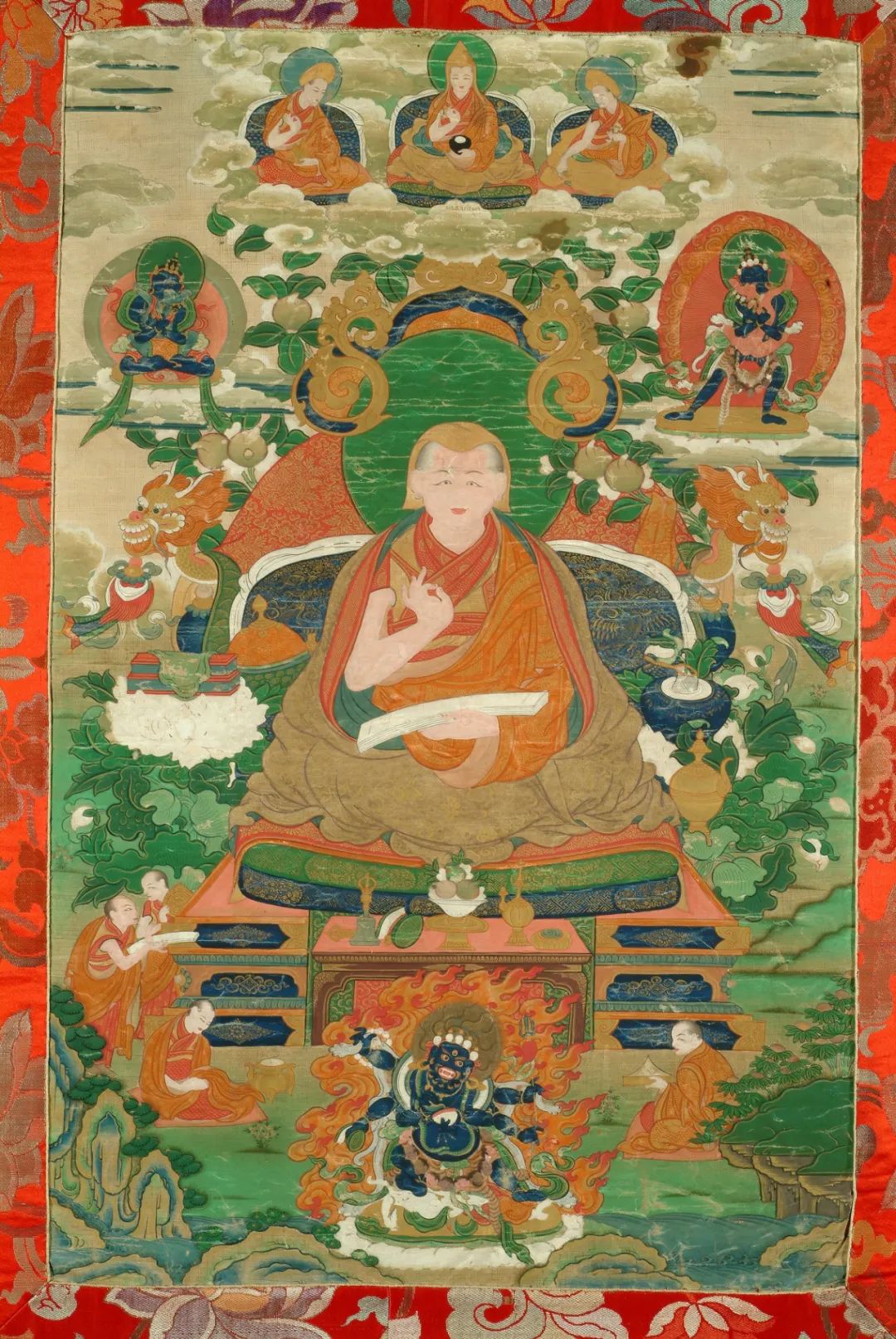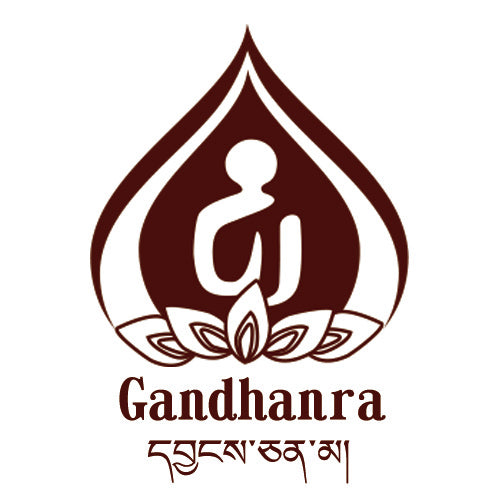
The various past lives of encyclopedia-style recluses: Masterpieces of composite art in the Himalayan art (Part Four)

"Rongtho Rinpoche: Awang Losang"
18th century, private collection
At the top of the painting are the Sixth Panchen Lama (1738-1780; left) and Pujongba Awangqinba (1682-1762; right).
At the bottom right of the painting is the Regent Dzogchen 8th Dalai Lama.
His "Biography of the Great Pan-chen Lama" is highly praised by people around the world.

Local: Regent Dazha of the Eighth Dynasty
Transformed into ordinary beings as wise guides.
May the Dharma be forever held and realized,
Infinite reverence for their boundless kindness and grace.
(1760-1810)
It is said to be the Er Gada Pearl (i.e. Blood Pearl)
Pearls include Valu and Kaz (i.e. Snake Pearl and Elephant Pearl)
Pearls like Ska and Ranba (i.e. Fish Pearl and Grass Pearl)
Saba Pearl (i.e. True Pearl) and lower parts
Maru pearls in total of seven categories, possibly from the brains of elephants and snakes
Also, due to the leaves of trees from India, pearls are produced when divine rain falls
Pearls are also produced when fish drink rain, with various colored pearls being the highest quality.
Selected from "The Essential Collection for Distinguishing Treasures"
by Lama Dondrub Awang Losang
In that year, there was a severe drought in Chamdo, and he had to move with his parents to another place. In his later autobiography, he described this experience as a series of misfortunes that led him to contemplate the law of cause and effect. His parents, who had lost five children, were preparing to send him to the Pabongka Monastery in Chamdo, even though two years had passed since the drought. This quiet and studious young man became a novice at the age of seven and formally received the novice vows at the age of twelve, with the vows being administered by the renowned "cave philosopher" in the Tibetan region - Pujokpa Awangqiangba.
The path of a philosopher is full of challenges, and the young man faced exclusion at the Jokhang Temple. However, his mentor, the late Ratak Ngorlozang Kunga Zangpo, firmly believed that he was the reincarnation of the deceased Tertön Kangyü Tsenam. In 1741, his mentor passed away. Before his death, the elderly teacher, who had leg ailments, arranged for a relative and eight assistants to accompany the young man to study in the holy city of Lhasa. They believed that the young man, with "warm light in his eyes," would accomplish great things. He was 22 years old that year.
The bustling market life in Lhasa and the restless academic atmosphere inside the monasteries instilled a sense of fear in the young man, who spent his entire life trying to distance himself from this unsettling environment. During his retreat at the Jé College of Sera Monastery, people teasingly referred to him as the "Loba Mad Monk." This nickname was not just because he was housed in the Loba monk quarter of the college but also because of his obsession with wisdom and practice, a story that still circulates in Sera Monastery to this day. In 1748, he received full ordination from Pujungwa Ngawang Qoigyi, a scholar who would go on to significantly influence the traditions and knowledge systems of the Gelugpa monastic colleges, marking the beginning of his lifelong quest for enlightenment.
If the first half of a young person's life is intertwined with academic studies at the monastery, the second half is fully embraced in a state of seclusion. In present-day Qushui County, there is a cave retreat known as "Longdo" (ཀློང་རྡོལ་རི་ཁྲོད་), initially famous as the meditation cave of the revered master Tertön Sangye Gyare (གཙང་པ་རྒྱ་རལ་; 1161-1211) of the Zhaba Kagyu tradition. Young people with footprints all over Tibet ultimately choose Longdo as their long-term retreat place, earning them the title of "Longdo Rinpoche" (ཀློང་རྡོལ་བླ་མ་).

"Partial view of the Potala Palace in Lhasa, Sacred Realm"
Early 19th century, Royal Ontario Museum Collection

"Takpu Kagyu Lineage Masters Lineage Chart" Partial: Zhaba Jaré
18th century, from the private collection of Doris Wiener
The Lhakhang Choje Kandzod Yeshe Monastery, with three parts dedicated to the goddesses and six hundred Avalokiteshvaras.
Surrounded by a hundred great enlightened monks, with eight hundred images painted on silk curtains.
Dancing ribbons and ringing bells, adorned with four rows of the five transcendent goddesses.
Excerpt from "Offering Silk Curtain to the Holy Lake Lhamo Lhatso"
by Venerable Lhundrup Awang Losang
When news spread that such a distinguished high lama was nearby, both monks and laypeople in Lhasa were eager to invite Rinpoche back to the city. Rinpoche decided to return to Lhasa in order to rest and receive more teachings. During his time in the sacred city, Rinpoche sought teachings from the 60th Ganden Tripa Losang Tenpa (1725-1782) and the 8th Panchen Lama Palden Tenpai Nyima (1758-1804); however, a dramatic turn of events occurred. When Rinpoche was appointed as the official sponsor by the regent at the time, the 6th Dalai Lama Ngawang Jampel Gyatso (1722-1777), the people of Lhasa could not find any trace of Rinpoche.
Not long after, the students of the master came to report: Master Longdo has already arrived at the Lozha Sekaguto Monastery, more than 300 kilometers away. "Obtaining teachings and then traveling, wandering in all directions"; compared to the hierarchical constraints of sacred places and prestigious institutions, the cool and serene meditation grounds of Marpa and Milarepa are the spiritual homes that Master Longdo longs for. In 1794, this leader and scholar who lived far away from the busy world passed away. To fulfill his pastoral-like practice wishes, the students held a grand sky burial ceremony for him (instead of the usual cremation).
Today, we can still catch a glimpse of the knowledge framework of the Dalai Lama from his collected works (or some missing works). In addition to a large number of works on the philosophical system of the Gelug school, the Dalai Lama also constructed knowledge frameworks for multiple disciplines. From biographies of great monastics to biographies of benefactors and protectors, while studying classical texts, there are also oral stories and strange anecdotes. From gemstone appreciation to ghost systems and divination summaries, people can freely navigate the knowledge ocean of objects and meanings.
The Gelug tradition considers him to be the embodiment of the great wrathful deity Vajrabhairava, while in modern studies, we respectfully refer to the Dalai Lama as a "encyclopedic achiever and classical scholar." Today, the NDTH Museum (Tibetan House) in New Delhi houses a set of paintings depicting the previous incarnations of the Dalai Lama. This series of paintings consists of seven pieces, with the Dalai Lama at the center and his past incarnations and teachings depicted on either side.

"The Lineage Chart of His Holiness Rongtong Tulku"
First Painting
His Holiness Rongtong Tulku
Early 18th century, in the collection of NDTH Museum
The high monks depicted from left to right are Pakpa Gyatso, the 6th Panchen Lama, and the 59th Ganden Tripa.
Pakpa Gyatso (1710-1772) was a respected Tibetan Buddhist lama.
The figures of Mijitsu and Gyalse are on either side of the supreme teacher.
The supreme teacher is considered a manifestation of the great wrathful Vajra.
The composition of the painting is similar to the image in the beginning of the text.
It is likely that the painting was completed by a painter from the Gongde Monastery and sent to the Litang region where the lineage of the Rongdo sect is located.

Local: Sanjosensei

"The Past Life Lineage of the Lord Rongdao"
Second Painting
Bodhisattva Tamwuhe
Early 18th century, collection of NDTH Museum.
Bodhisattva Samantabhadra (འཕགས་པ་) expounds the wisdom of prajna,
Before him sits the constant weeping Bodhisattva who seeks the dharma (རྟག་ཏུ་རྔུ་),
The great master Longdho is the lineage holder of the Prajna teachings.

Local: The Bodhisattva Nantai and the Elder Offering Charity to a Woman

"Lineage Chart of the Previous Lives of Guru Rinpoche
Third Image
Princess Nechung of Nepal
Early 18th Century, NDTH Museum Collection"
The great master Longdu often practices the teachings of the Goddess Tara as a core meditation deity, with the Green Tara being one of the principal manifestations. In the upper left corner is the first Buddhist nun, the beloved aunt of Buddha, Devadatta.

Partial: Bhikkhuni's great love for the dharma

"The Lineage Chart of Rongdo Rinpoche's Previous Lives"
Fourth painting
With the merit light above and the colorful forest below
Early 18th century, NDTH Museum collection
The Source of Merit and Virtue, the Essence of the Vinaya
Venerable Serlingpa at Adhiṣastra

Partial: The Light of merit Guru Shijin and Serimpa Guru Maitreya

"The Previous Lives Lineage Chart of Lama Zopa Rinpoche"
Fifth Image
Above: Accomplished Master Jigme Yeshe and Below: Translator Marpa Lotsawa
Early 18th century, NDTH Museum Collection
Lama Thubten Yeshe inherited the lineage of both Vajrasattva and Vajrayogini practices from his previous lives.

Local: Marba translator and his wife

"The Past Life Lineage Chart of Rongdo Rinpoche"
Sixth Panel
Above: E Qu Qugduoji and Below: Litang Kangqin
Early 18th century, NDTH Museum Collection
Ek Quqduoji was a disciple of Marpa Lotsawa
(1023-1090; main disciple of Guru Rinpoche)
Litang Kangqin is considered to be the previous incarnation of Longchenpa
He is believed to be the reincarnation of Orgyen Lingpa

Local: The master-disciple relationship between Ek Qu Ge Duoji and Marba

"The Previous Life Lineage of the Great Guru Rongzompa"
Seventh Panel
Above, the great wise Siddha Chakrasamvara and below, the powerful King Jigme of Shambhala
Early 18th century, collected by NDTH Museum.
The Great Sage Pangco Jiacuo
(17th century)
A holder of the powerful Vajrayana tradition
One of the key disciples of Litang Khenpo

Local: Chago sage and Litang Kanqin master and disciple

The Law Lineage of the Omniscient Sage

